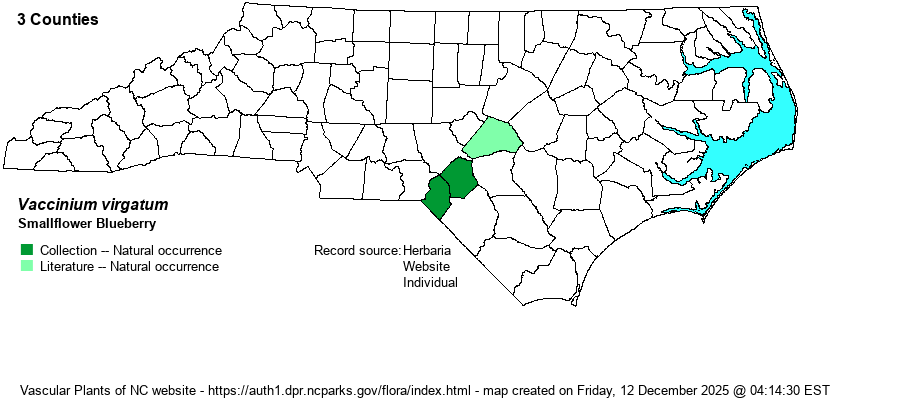| Author | Aiton | |
| Distribution | Strictly in the Coastal Plain, just the southern Sandhills part of the province. Range maps seem to be cluttered with possibly erroneous reports; verified specimens exist for only the Sandhills region. For example, the NCNHP gives records for 12 counties, but only three (one erroneously in the Mountains) are documented with collections in the SERNEC database.
This is a poorly known species of the Southeastern states, ranging north to southeastern NC and to the Gulf Coast, west to eastern TX. It is most numerous in the western Gulf Coast states.
| |
| Abundance | Seemingly rare in the state, but few botanists are familiar with the species and most would probably overlook it where present, as there are relatively few good references with photos and descriptive text. The NCNHP considered it a Significantly Rare species in 2016, but currently now has downgraded it to a Watch List species. That may be premature to consider it not a truly rare species in NC. | |
| Habitat | This is a very poorly known shrub in the state; apparently it is found in wet pine flatwoods and streamhead ecotones. Occurrences in blackwater swamps, pocosins, and other truly wet sites are unverified. | |
| Phenology | Flowers in March and April, presumably before or as the leaves unfurl; fruits in May and June. | |
| Identification | This is a small to medium-sized deciduous shrub that has few if any definitive vegetative characters. It averages 3-6 feet tall, and it has narrowly elliptic leaves to 2 inches long. However, it has very small flowers, only to 5 mm long (1/5-1/4-inch long); these are bell- or urn-shaped and mostly white. Also, the fruit (berries) are quite small as well, again averaging only about 5 mm across. Weakley’s (2018) key mentions that the leaves have stipitate glands on the lower surface. In general, it looks like a larger version of V. tenellum, but with leaves slightly more elliptic. It should be pointed out that the great majority of the NC records have come from N.C. Vegetation Survey plots, where all species are tallied within a plot. Though this does not mean that specimens were not collected (and most are not in herbaria), it does suggest that errors are possible as biologists attempt to put a name on each species within a plot. In such cases, botanists often collect specimens of unknown species and key them out later, in which case there is no in-the-field familiarity with such a species. As so few of the state records are away from such plots, it means that very few people are familiar with it and know what to look for in the field. Most references offer little help, or the “help” is confusing! | |
| Taxonomic Comments | The species was formerly known as Vaccinium amoenum, at least in RAB (1968). Some entities subsumed this species within the very broad V. corymbosum, which has now been split into a number of species.
| |
| Other Common Name(s) | Rabbit-eye Blueberry, Southern Highbush Blueberry, Swamp Blueberry, Southern Swamp Blueberry | |
| State Rank | S1S2 | |
| Global Rank | G4 | |
| State Status | W7 [SR] | |
| US Status | | |
| USACE-agcp | | |
| USACE-emp | | |

